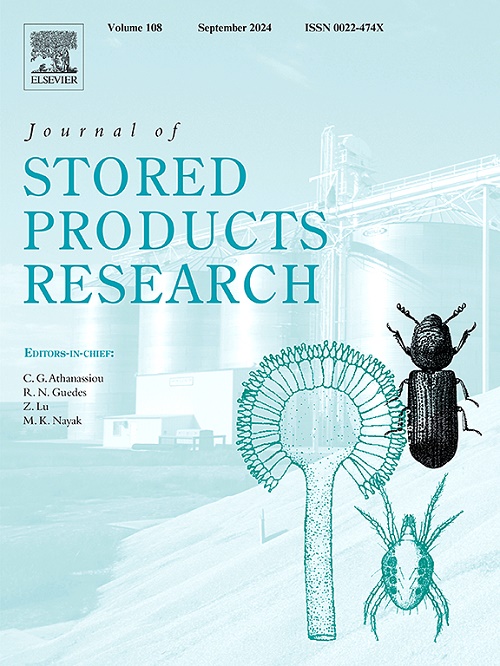面粉甲虫对未感染和以前感染的小麦粉中挥发性有机化合物的反应
IF 2.7
2区 农林科学
Q1 ENTOMOLOGY
引用次数: 0
摘要
昆虫介导的粮食产品中挥发性有机化合物(VOCs)的变化可以引发一系列影响,阻止或促进随后的虫害。这些符号化学线索有望开发基于行为的虫害监测水平和管理策略。本研究验证了具有castaneum侵染历史的小麦粉通过在先前定殖过程中产生或消耗的特定半化学物质改变昆虫偏好和发育的假设。在未侵染和以前侵染的面粉中检测到挥发性有机化合物的显著差异。关键化合物如蔗糖、亚油酸乙酯、邻苯二甲酸酯和N-(2-羟乙基)十烷酰胺只出现在未感染的面粉中,而十六烯酸、亚油酸和11-甲基五烷是甲虫感染的面粉所特有的。生物分析表明,与受侵染的面粉相比,未侵染的面粉具有更高的消费量、食物转化效率、昆虫生长、繁殖和面粉损失。然而,两种基质对昆虫的初始偏好无显著差异。结果表明,在未侵染面粉中发现的某些挥发性有机化合物可能会降低初始吸引力,但会促进消费,而侵染面粉中特有的挥发性有机化合物会增强定植偏好,但会抑制取食。重要的是,底物偏好本身并不能预测消费量,而消费量是昆虫发育、后代生产和小麦粉降解的关键驱动因素。这些发现加深了我们对面粉甲虫与化学物质相互作用的理解,并为基于VOC控制的害虫防治策略提供了基础。本文章由计算机程序翻译,如有差异,请以英文原文为准。
Flour beetle responses to volatile organic compounds from uninfested and previously infested wheat flour
Insect-mediated changes in volatile organic compounds (VOCs) within grain products can trigger a cascade of effects that either deter or promote subsequent infestation. These semiochemical cues hold promise for developing behavior-based monitoring pest infestation levels and management strategies. This study tested the hypothesis that wheat flour with a history of Tribolium castaneum infestation alters insect preference and development through specific semiochemicals generated or depleted during prior colonization. Significant differences in VOC profiles were detected between uninfested and previously infested flour. Key compounds such as sucrose, ethyl linoleate, phthalic acid ester, and N-(2-hydroxyethyl) decanamide appeared exclusively in uninfested flour, while hexadecenoic acid, linoelaidic acid, and 11-methylpentacosane were unique to beetle-infested flour. Biological assays revealed that uninfested flour supported greater consumption, food conversion efficiency, insect growth, reproduction, and flour loss compared to infested flour. However, no significant difference in initial insect preference between the two substrates was observed. Results suggest that certain VOCs found in uninfested flour may reduce initial attraction but promote consumption, whereas VOCs unique to infested flour enhance colonization preference but suppress feeding. Importantly, substrate preference alone does not predict consumption, which is the key driver of insect development, progeny production, and wheat flour degradation. These findings deepen our understanding of flour beetle-chemical interactions and provide a foundation for targeted pest control strategies based on VOC manipulation.
求助全文
通过发布文献求助,成功后即可免费获取论文全文。
去求助
来源期刊
CiteScore
5.70
自引率
18.50%
发文量
112
审稿时长
45 days
期刊介绍:
The Journal of Stored Products Research provides an international medium for the publication of both reviews and original results from laboratory and field studies on the preservation and safety of stored products, notably food stocks, covering storage-related problems from the producer through the supply chain to the consumer. Stored products are characterised by having relatively low moisture content and include raw and semi-processed foods, animal feedstuffs, and a range of other durable items, including materials such as clothing or museum artefacts.

 求助内容:
求助内容: 应助结果提醒方式:
应助结果提醒方式:


